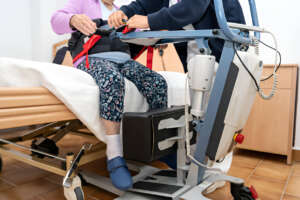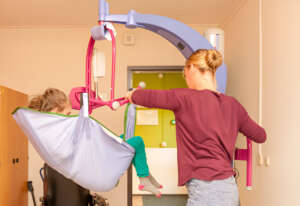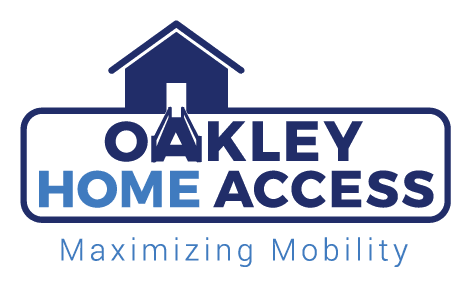Comprehensive Guide to Patient Lift Systems: Ensuring Safe and Efficient Transfers
Patient lift systems and transfer solutions are essential for safe patient handling in homes at Worcester, MA, significantly reducing the risk of injuries for both patients and caregivers in the area. In this article, we’ll explore various types of patient lift systems, including Portable Lifts, Ceiling Mounted Lifts, Overhead Lifts, the Orbit Lift, Independent Slings, and Pool Lifts, to guide you in selecting the best lift system for your needs.
Key Takeaways
- Patient lift systems enhance safety and ease during transfers for individuals with limited mobility, minimizing caregiver strain and injury risks.
- Different lift systems, such as Portable Lifts, Ceiling Mounted Lifts, and Overhead Lifts, along with other mobility aids, cater to various mobility needs and environments, improving safety and comfort
- Selecting the right lift system requires evaluating patient needs, caregiver capabilities, and space dimensions to ensure effective and safe operation.

Understanding Patient Lift Systems
Patient lift systems are indispensable tools in healthcare facilities across Worcester, MA, designed to provide safe and effective transfers for individuals with limited mobility. These systems play a crucial role in reducing caregiver strain, and making patient transfer safer and more efficient. The primary function of a patient lift is to facilitate smooth transitions between environments, minimizing injury risks.
What is a Patient Lift?
A patient lift is a medical device that assists caregivers in safely transferring individuals with limited mobility, such as moving them from a bed to a wheelchair or toilet. These devices reduce injury risks for both caregivers and patients while ensuring safe handling.
Patient lifts include overhead, ceiling, and floor-based models. When choosing a lift, consider its safe working load, especially for bariatric patients, and an adjustable base for versatility in different spaces.
Patient lifts support standing, prevent pressure ulcers, and enhance mobility and independence. By selecting the right lift, you can ensure safe, efficient transfers and improved care quality for all involved.
Portable Lifts
Assistive devices like portable lifts are designed with mobility and convenience in mind, assisting with daily transfers in various locations around Worcester, MA. These lifts are lightweight and can be folded or disassembled for easy travel and storage, making them ideal for home care settings or situations requiring frequent movement between rooms. Portable lifts provide consistent support for patients throughout the day, offering a practical solution for maintaining mobility and independence.
Ceiling Mounted Lifts
Ceiling-mounted lifts offer an innovative solution for safe and efficient patient transfers. Mounted on the ceiling, these lifts facilitate smooth transfers and reduce fall risks with their ergonomic design, enhancing safety and comfort. A significant advantage of ceiling lifts is their space-saving design, requiring minimal floor space and making them ideal for small rooms or areas with limited space. Additionally, ceiling lifts enhance hygiene by avoiding contact with floor surfaces.
Overhead Lifts
Overhead lifts are a type of ceiling lift system providing seamless patient transfers across various settings. These lifts operate on a ceiling-installed track system, allowing smooth, continuous movement throughout a room or facility. Overhead lifts are particularly beneficial in hospitals where multiple transfers are needed daily. They offer flexibility in positioning and can accommodate various sling types, ensuring patient safety and comfort.
Orbit Lift
The Orbit Lift is a versatile patient lift system designed for ease of use and flexibility. Featuring a unique rotating design, it allows for 360-degree movement, enabling caregivers to maneuver patients with minimal effort. This lift is particularly useful in tight spaces where traditional lifts may be challenging to operate. The Orbit Lift’s design ensures smooth and safe transfers, enhancing both patient comfort and caregiver efficiency.
Independent Slings
Sling options are a critical component of patient lift systems, offering varied support and comfort levels during transfers. These slings accommodate different patient needs, from full-body support to targeted assistance. Independent slings can be used with various lift systems, including ceiling and portable lifts, providing flexibility in patient handling. Choosing the right sling is essential for ensuring patient safety and comfort, as it directly impacts transfer stability and security.
Pool Lifts
Pool lifts are specialized systems designed to assist individuals with limited mobility in accessing swimming pools safely. These lifts provide a secure and comfortable way for patients to enter and exit the pool, promoting aquatic therapy and recreational activities. Typically installed poolside, pool lifts can be operated manually or electrically, ensuring inclusivity and accessibility in aquatic environments. They enhance safety and independence, making them valuable for both public and private pools.
Key Considerations When Choosing a Patient Lift System
Selecting the right patient lift system requires careful consideration of several factors.
- Assess Patient Needs: Evaluate the patient’s mobility level and weight. Bariatric patients will need lifts with higher weight capacities, while those with some mobility might benefit from sit-to-stand lifts.
- Consider Caregiver Capabilities: Take into account the caregiver’s strength and dexterity to ensure the selected lift system is manageable and easy to operate.
- Measure Space Dimensions: Ensure the lift can be accommodated within the available space, particularly important for ceiling lifts that require specific installations.
- Evaluate Portability: Consider if the lift needs to be moved between rooms or stored easily, which is crucial for maintaining convenience and flexibility.
- Safety and Efficiency: By considering these factors, caregivers can select a lift system that best meets their needs, ensuring safe and efficient patient transfers.
How to Operate Patient Lift Systems Safely
Safe operation of patient lift systems is paramount to preventing injuries and ensuring smooth transfers. Electric patient lifts often feature powered retractable lift tapes, simplifying operation. It’s crucial to use the appropriate sling for each lift, as the sling type affects patient comfort and stability during transfers.

Emergency controls ensure patient safety in case of power failure or other emergencies. Improper use of patient lifts can lead to injuries, so following the manufacturer’s instructions and safety guidelines is vital.
Regular maintenance and training further enhance safe operation, promoting secure and efficient transfers.
Benefits of Using Patient Lift Systems in Your Worcester, MA Home
The benefits of using patient lift systems are manifold, significantly improving the quality of care for both patients and caregivers. T
- Reduces Injury Risks: Patient lift systems significantly lower the risk of injuries during transfers, creating a safer environment for both patients and caregivers.
- Prevents Caregiver Strain: Mechanical lifts help prevent musculoskeletal disorders in caregivers by reducing physical strain, allowing them to perform their duties more effectively.
- Enhances Patient Independence: By incorporating patient lifts into home care, patients can experience improved quality of life through greater independence and mobility.
- Promotes Freedom of Movement: These systems empower patients to move with more freedom, fostering a sense of dignity and self-reliance.
- Decreases Staff Injuries: Implementing safe patient-handling
Summary
In conclusion, patient handling equipment, including patient lift systems, plays a crucial role in ensuring safe and efficient transfers for individuals with limited mobility. The diverse range of systems, including Portable Lifts, Ceiling Mounted Lifts, Overhead Lifts, the Orbit Lift, Independent Slings, and Pool Lifts, are tailored to meet various needs, enhancing both safety and comfort. By alleviating caregiver strain and reducing injury risks, these lift systems are fundamental to delivering high-quality care.
Selecting the appropriate lift system in requires a careful evaluation of patient needs, caregiver capabilities, and the spatial dimensions of the environment. With proper use and maintenance, these systems can significantly improve the lives of patients and caregivers, fostering independence and enhancing the overall quality of life.
Choose Oakley Home Access for your Patient Lift System Needs in Worcester, MA
Experience the benefits of working with home safety experts dedicated to aging in place, fall prevention, and home accessibility. As a team owned and operated by registered, licensed CAPS certified contractors and registered, licensed occupational therapists, we ensure that every solution is tailored with function and safety in mind. Take advantage of our free home safety assessments and let us help you create a safer living environment. Contact us today to learn more about our services and how we can assist you!
Frequently Asked Questions
What are the main types of patient lift systems available?
The main types of patient lift systems available in Worcester, MA include Portable Lifts, Ceiling-Mounted Lifts, Overhead Lifts, the Orbit Lift, Independent Slings, and Pool Lifts, each designed to meet specific needs in patient care. Understanding these options can enhance safety and ease during patient transfers.
How do ceiling lifts benefit patient transfers?
Ceiling lifts with ergonomic design provide significant benefits in patient transfers by enhancing safety and comfort while minimizing caregiver strain. Their design is particularly advantageous in limited spaces, ensuring efficient and effective transfers.
What should I consider when choosing a patient lift system?
When choosing a patient lift system and assistive devices, it is crucial to consider the patient’s mobility level and weight, the caregiver’s strength, the dimensions of the space, and the portability of the lift system. These factors ensure safety and efficiency in patient handling.
How can I ensure the safe operation of patient lift systems?
To ensure the safe operation of patient lift systems, always use the correct sling, adhere to the manufacturer’s guidelines, and confirm that the liftis in good working condition before each use. Regular maintenance checks and proper training for caregivers are also essential to prevent accidents and injuries.
